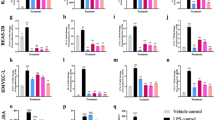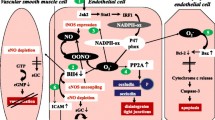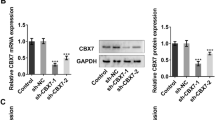Abstract
Introduction
Impaired mitochondrial function is a key factor attributing to the lung ischemia reperfusion injury (LIRI). Methylene blue (MB) has been reported to attenuate brain and renal ischemia–reperfusion injury. We hypothesized that MB also could have a protective effect against LIRI by preventing mitochondrial oxidative damage.
Methods
Isolated rat lungs were assigned to the following four groups (n = 6): a sham group: perfusion for 105 min without ischemia; I/R group: shutoff of perfusion and ventilation for 45 min followed by reperfusion for 60 min; and I/R + MB group and I/R + glutathione (GSH) group: 2 mg/kg MB or 4 μM glutathione were intraperitoneally administered for 2 h, and followed by 45 min of ischemia and 60 min of reperfusion.
Results
MB lessened pulmonary dysfunction and severe histological injury induced by ischemia–reperfusion injury. MB reduced the production of reactive oxygen species and malondialdehyde and enhanced the activity of superoxide dismutase. MB also suppressed the opening of the mitochondrial permeability transition pore and partly preserved mitochondrial membrane potential. Moreover, MB inhibited the release of cytochrome c from the mitochondria into the cytosol and decreased apoptosis. Additionally, MB downregulated the mRNA expression levels of pro-inflammatory cytokines (TNF-α, IL-1β, IL-6, and IL-18).
Conclusion
MB protects the isolated rat lungs against ischemia–reperfusion injury by attenuating mitochondrial damage.






Similar content being viewed by others
References
Ferrari RS, Andrade CF (2015) Oxidative stress and lung ischemia-reperfusion injury. Oxidative med cell longev 2015:590987. https://doi.org/10.1155/2015/590987
Ovechkin AV, Lominadze D, Sedoris KC, Robinson TW, Tyagi SC, Roberts AM (2007) Lung ischemia-reperfusion injury: implications of oxidative stress and platelet-arteriolar wall interactions. Arch Physiol Biochem 113(1):1–12. https://doi.org/10.1080/13813450601118976
Eltzschig HK, Eckle T (2011) Ischemia and reperfusion–from mechanism to translation. Nat Med 17(11):1391–1401. https://doi.org/10.1038/nm.2507
Eltzschig HK, Bratton DL, Colgan SP (2014) Targeting hypoxia signalling for the treatment of ischaemic and inflammatory diseases. Nat Rev Drug Discov 13(11):852–869. https://doi.org/10.1038/nrd4422
Silachev DN, Plotnikov EY, Pevzner IB, Zorova LD, Babenko VA, Zorov SD, Popkov VA, Jankauskas SS, Zinchenko VP, Sukhikh GT, Zorov DB (2014) The mitochondrion as a key regulator of ischaemic tolerance and injury. Heart Lung Circ 23(10):897–904. https://doi.org/10.1016/j.hlc.2014.05.022
Nederlof R, Eerbeek O, Hollmann MW, Southworth R, Zuurbier CJ (2014) Targeting hexokinase II to mitochondria to modulate energy metabolism and reduce ischaemia-reperfusion injury in heart. Br J Pharmacol 171(8):2067–2079. https://doi.org/10.1111/bph.12363
Murphy E, Steenbergen C (2008) Mechanisms underlying acute protection from cardiac ischemia-reperfusion injury. Physiol Rev 88(2):581–609. https://doi.org/10.1152/physrev.00024.2007
Souidi N, Stolk M, Seifert M (2013) Ischemia-reperfusion injury: beneficial effects of mesenchymal stromal cells. Curr Opin Organ Transplant 18(1):34–43. https://doi.org/10.1097/MOT.0b013e32835c2a05
Yang SH, Li W, Sumien N, Forster M, Simpkins JW, Liu R (2015) Alternative mitochondrial electron transfer for the treatment of neurodegenerative diseases and cancers: methylene blue connects the dots. Prog Neurobiol. https://doi.org/10.1016/j.pneurobio.2015.10.005
Kuliaviene I, Baniene R, Virketyte S, Kincius M, Jansen E, Gulbinas A, Kupcinskas L, Trumbeckaite S, Borutaite V (2016) Methylene blue attenuates mitochondrial dysfunction of rat kidney during experimental acute pancreatitis. J dig dis 17(3):186–192. https://doi.org/10.1111/1751-2980.12328
Lin X, Wu BB, Xing QY, Wang SD, Li J (2015) Methylene blue, a potential therapeutic target for mitochondria dysfunction. Int Immunopharmacol 28(2):1106–1107. https://doi.org/10.1016/j.intimp.2015.08.024
Ahmed ME, Tucker D, Dong Y, Lu Y, Zhao N, Wang R, Zhang Q (2016) Methylene blue promotes cortical neurogenesis and ameliorates behavioral deficit after photothrombotic stroke in rats. Neuroscience 336:39–48. https://doi.org/10.1016/j.neuroscience.2016.08.036
Wiklund L, Sharma A, Sharma HS (2016) Neuroprotection by Methylene blue in cerebral global ischemic injury induced blood-brain barrier disruption and brain pathology. CNS Neurol Disord Drug Target 15(9):1181–1187
Sarac F, Kilincaslan H, Kilic E, Koldas M, Terzi EH, Aydogdu I (2015) Methylene blue attenuates renal ischemia-reperfusion injury in rats. J Pediatr Surg 50(6):1067–1071. https://doi.org/10.1016/j.jpedsurg.2014.06.018
Collange O, Charles AL, Bouitbir J, Chenard MP, Zoll J, Diemunsch P, Thaveau F, Chakfe N, Piquard F, Geny B (2013) Methylene blue protects liver oxidative capacity after gut ischaemia-reperfusion in the rat. Eur J Vasc Endovasc Surg 45(2):168–175. https://doi.org/10.1016/j.ejvs.2012.11.011
Weinbroum AA (2009) Methylene blue attenuates pancreas ischemia-reperfusion (IR)-induced lung injury: a dose response study in a rat model. J Gastrointest Surg 13(9):1683–1691. https://doi.org/10.1007/s11605-009-0945-0
Abreu Mda M, Pazetti R, Almeida FM, Correia AT, Parra ER, Silva LP, Vieira RP, Pego-Fernandes PM, Jatene FB (2014) Methylene blue attenuates ischemia- reperfusion injury in lung transplantation. J Surg Res 192(2):635–641. https://doi.org/10.1016/j.jss.2014.07.043
Chen JL, Dai L, Zhang P, Chen W, Cai GS, Qi XW, Hu MZ, Du B, Pang QF (2015) Methylene blue attenuates acute liver injury induced by paraquat in rats. Int Immunopharmacol 28(1):808–812. https://doi.org/10.1016/j.intimp.2015.04.044
Setzer F, Oschatz K, Hueter L, Schmidt B, Schwarzkopf K, Schreiber T (2013) Susceptibility to ventilator induced lung injury is increased in senescent rats. Crit Care 17(3):R99. https://doi.org/10.1186/cc12744
Kristian T, Gertsch J, Bates TE, Siesjo BK (2000) Characteristics of the calcium-triggered mitochondrial permeability transition in nonsynaptic brain mitochondria: effect of cyclosporin A and ubiquinone O. J Neurochem 74(5):1999–2009
Galindo MF, Jordan J, Gonzalez-Garcia C, Cena V (2003) Reactive oxygen species induce swelling and cytochrome c release but not transmembrane depolarization in isolated rat brain mitochondria. Br J Pharmacol 139(4):797–804. https://doi.org/10.1038/sj.bjp.0705309
Emaus RK, Grunwald R, Lemasters JJ (1986) Rhodamine 123 as a probe of transmembrane potential in isolated rat-liver mitochondria: spectral and metabolic properties. Biochim Biophys Acta 850(3):436–448
Roman M, Gjorgjimajkoska O, Neil D, Nair S, Colah S, Parmar J, Tsui S (2015) Comparison between cellular and acellular perfusates for ex vivo lung perfusion in a porcine model. J Heart Lung Transplant 34(7):978–987. https://doi.org/10.1016/j.healun.2015.03.023
Nelson K, Bobba C, Ghadiali S, Hayes D Jr, Black SM, Whitson BA (2014) Animal models of ex vivo lung perfusion as a platform for transplantation research. World J Exp Med 4(2):7–15. https://doi.org/10.5493/wjem.v4.i2.7
Wendel A, Jaeschke H, Gloger M (1982) Drug-induced lipid peroxidation in mice–II. Protection against paracetamol-induced liver necrosis by intravenous liposomally entrapped glutathione. Biochem Pharmacol 31(22):3601–3605
Schauer RJ, Gerbes AL, Vonier D, Meissner H, Michl P, Leiderer R, Schildberg FW, Messmer K, Bilzer M (2004) Glutathione protects the rat liver against reperfusion injury after prolonged warm ischemia. Ann Surg 239(2):220–231. https://doi.org/10.1097/01.sla.0000110321.64275.95
Atamna H, Mackey J, Dhahbi JM (2012) Mitochondrial pharmacology: electron transport chain bypass as strategies to treat mitochondrial dysfunction. BioFactors 38(2):158–166. https://doi.org/10.1002/biof.197
Gabrielli D, Belisle E, Severino D, Kowaltowski AJ, Baptista MS (2004) Binding, aggregation and photochemical properties of methylene blue in mitochondrial suspensions. Photochem Photobiol 79(3):227–232
Sommer SP, Sommer S, Sinha B, Wiedemann J, Otto C, Aleksic I, Schimmer C, Leyh RG (2011) Ischemia-reperfusion injury-induced pulmonary mitochondrial damage. J Heart Lung Transplant 30(7):811–818. https://doi.org/10.1016/j.healun.2011.02.001
Brinkkoetter PT, Song H, Losel R, Schnetzke U, Gottmann U, Feng Y, Hanusch C, Beck GC, Schnuelle P, Wehling M, van der Woude FJ, Yard BA (2008) Hypothermic injury: the mitochondrial calcium, ATP and ROS love-hate triangle out of balance. Cell Physiol Biochem 22(1–4):195–204. https://doi.org/10.1159/000149797
Guo Z, Yu S, Chen X, Ye R, Zhu W, Liu X (2016) NLRP3 Is Involved in Ischemia/Reperfusion Injury. CNS Neurol Disord: Drug Targets 15(6):699–712
Mao LL, Hao DL, Mao XW, Xu YF, Huang TT, Wu BN, Wang LH (2015) Neuroprotective effects of bisperoxovanadium on cerebral ischemia by inflammation inhibition. Neurosci Lett 602:120–125. https://doi.org/10.1016/j.neulet.2015.06.040
Shen X, Du J, Zhao Y, Guan W (2014) Phosphatase Wip1 as a new therapeutic target for intestinal ischemia-reperfusion injury. Expert Rev Clin Immunol 10(12):1591–1595. https://doi.org/10.1586/1744666X.2014.975211
Fang T, Zhou D, Lu L, Tong X, Wu J, Yi L (2016) LXW7 ameliorates focal cerebral ischemia injury and attenuates inflammatory responses in activated microglia in rats. Braz J Med Biol Res 49(9):e5287. https://doi.org/10.1590/1414-431X20165287
Fenn AM, Skendelas JP, Moussa DN, Muccigrosso MM, Popovich PG, Lifshitz J, Eiferman DS, Godbout JP (2015) Methylene blue attenuates traumatic brain injury-associated neuroinflammation and acute depressive-like behavior in mice. J Neurotrauma 32(2):127–138. https://doi.org/10.1089/neu.2014.3514
Funding
This work was supported by the following Grants: National Natural Science Foundation of China (81270126); Fundamental Research Funds for the Central Universities (JUSRP51412B); The Science Funds for Health and Family Planning Commission of Sichuan Province (150234); Jiangsu Province Natural Science Foundation (BK20161141); and Graduate Student Research Innovation Project (KYZZ16_0312, KYLX15_1196).
Author information
Authors and Affiliations
Corresponding authors
Ethics declarations
Conflict of interest
The authors declare that they have no conflict of interest.
Ethical Approval
This research involved rats. The study was approved by the Animal Care and Use Committee of Jiangnan University.
Rights and permissions
About this article
Cite this article
Tian, Wf., Zeng, S., Sheng, Q. et al. Methylene Blue Protects the Isolated Rat Lungs from Ischemia–Reperfusion Injury by Attenuating Mitochondrial Oxidative Damage. Lung 196, 73–82 (2018). https://doi.org/10.1007/s00408-017-0072-8
Received:
Accepted:
Published:
Issue Date:
DOI: https://doi.org/10.1007/s00408-017-0072-8




